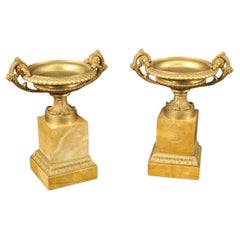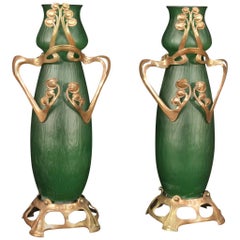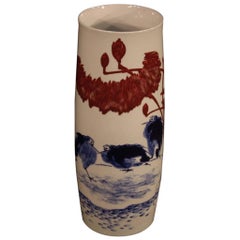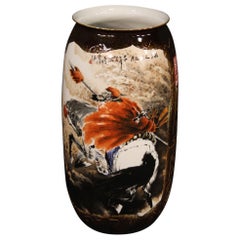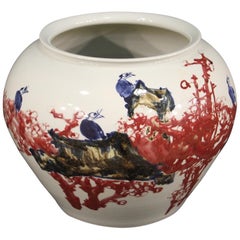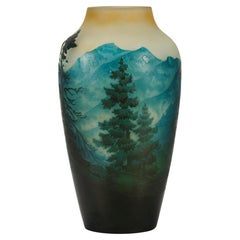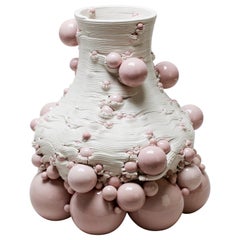Parino Mercato Antiquario Vases and Vessels
to
4
3
4
3
4
1
1
1
1
4
3
1
1
1
7
4
3
3
3
2
Height
to
Width
to
7
7
7
20th Century Golden Bronze and Yellow Marble Italian Centerpieces, 1930s
Located in Vicoforte, Piedmont
Pair of Italian centerpieces from the first half of the 20th century. Objects in gilded and chiseled bronze with a square plinth base veneered in marble. Centerpieces of fabulous dec...
Category
Vintage 1930s Italian Vases
Materials
Marble, Bronze
Pair of 20th Century Glass and Metal French Art Nouveau Style Vases, 1950
Located in Vicoforte, Piedmont
Pair of French vases from the mid-20th century. Beautifully sized glass objects with chiseled metal decorations (copper tint) in Art Nouveau style and pleasant decor. Vases for antiq...
Category
Mid-20th Century French Art Nouveau Vases
Materials
Metal
20th Century Enameled and Hand Painted Ceramic Italian Vase, 1950
Located in Vicoforte, Piedmont
Large Italian vase of the mid-20th century. Ceramic object enameled and hand painted with decorations of character and oriental style. Vase with lid adorned with sculpture depicting ...
Category
Vintage 1950s Italian Ceramics
Materials
Ceramic
21st Century Painted and Glazed Ceramic Chinese Landscape Vase, 2000
Located in Vicoforte, Piedmont
Chinese vase from the early 21st century. Hand painted ceramic work of Jingdezhen depicting a stylized landscape with excellent quality flowers and animals. Object adorned with Chine...
Category
21st Century and Contemporary Chinese Vases
Materials
Ceramic
21st Century Glazed and Painted Ceramic Chinese Vase, 2000
Located in Vicoforte, Piedmont
Chinese vase from the early 21st century. Jingdezhen ceramic work glazed and painted by hand with warrior on horse and Chinese written of excellent quality. Vase of beautiful size an...
Category
21st Century and Contemporary Chinese Vases
Materials
Ceramic
21st Century Glazed and Painted Ceramic Chinese Vase With Flowers, 2000
Located in Vicoforte, Piedmont
Chinese vase from the beginning of the 21st century. Work in glazed and hand painted ceramic with floral and animal decorations. Vase of excellent proportion with a top opening of 23...
Category
21st Century and Contemporary Chinese Vases
Materials
Ceramic
Pair of 20th Century Painted Metal Oriental Pair of Vases, 1960
Located in Vicoforte, Piedmont
Pair of oriental vases from 20th century. Objects in chiselled metal in cloisonné style of beautiful line and pleasant decor. Vases with side h...
Category
Vintage 1960s Asian Vases
Materials
Metal
Related Items
Early 20th Century French Art Nouveau Glass "Mountain Vase" by Emile Gallé
By Gallé
Located in London, GB
A stunning late 19th Century French cameo glass vase decorated with deep green conifer and mountainous backdrop in an attractive green and turquoise colour against a variegating yell...
Category
Early 20th Century French Art Nouveau Vases
Materials
Glass
$5,968
H 9.85 in W 5.52 in D 5.52 in
White Ceramic Sculptural Vase Italian Contemporary, 21st Century contemporary
By Andrea Salvatori
Located in London, GB
"Composizione 40100 #11" (Maestoso con gioco), 2019, glazed earthenware, measures: H 41 x38 x 38cm
Mix of hand-made and 3D printed - Unique piece
Andrea Salvatori (Italy, 1975) is an internationally renowned visual artist working with the ceramic medium to realize often ironic and witty sculptures, sometimes involving a diverse selection of found objects, such as Murano glass vases, Meissen Porcelain miniatures or Ginori period ceramics sourced in flea markets around Europe. Salvatori’s works often begin with these items and proceed by the addition of elements masterfully created by the artist, generating an unexpected semantic shift. The result is unique, encompassing pop culture and kitsch aesthetics: a witty and effective way to turn reality upside-down and at the same time a powerful combination of exquisite craftsmanship and genuine irony.
Andrea Salvatori was born on 3 of March 1975 in Faenza (Ra), Italy; he has graduated at the Istituto d’arte for Ceramic in Faenza in 1995, and he then graduated with a Degree in Sculpture at the Accademia di Belle Arti of Bologna in 2000. During his studies, Andrea learned the secrets of ceramics from the creative duo Bertozzi & Casoni having worked as an apprentice in their studio for many years at the same way as during Renaissance artists learned their practice with their Masters. Since 1997 he had several individual and collective exhibitions. In 2009 he won the first prize at the 56th edition of the prestigious Premio Faenza, the International Contest of Contemporary Art Ceramics, for which he classified second in the prior edition. In 2011 he classified second at the Sidney Myer Fund Australian Ceramic...
Category
21st Century and Contemporary Italian Vases
Materials
Ceramic, Earthenware
$13,309
H 16.15 in W 14.97 in D 14.97 in
Porcelain Ceramic and 18k Gold Sculptural Vase Italy Contemporary, 21st Century
By Andrea Salvatori
Located in London, GB
"TuttiTappi (Surprise!)", 2022, porcelain found object, earthenware, and 18K gold
H 35 x 20 cm
Real 18K gold has been applied through third firing on the internal sculptural elem...
Category
21st Century and Contemporary Italian Victorian Vases
Materials
Gold
$6,174
H 13.78 in Dm 7.88 in
21st Century 'Flowers Pattern' Vase in White Ceramic, Hand-Crafted in France
By Inhee Ma
Located in Marchaux-Chaudefontaine, FR
‘Flowers Pattern’ Handmade White Ceramic Vase
This vase is part of a new series inspired by iconic Art (and more precisely paintings) movements. Here is our Lune [M] model with moti...
Category
2010s European Minimalist Vases
Materials
Clay, Stoneware
$279 / item
H 9.06 in W 10.24 in D 0.79 in
Porcelain & Ceramic Sculptural Vase Italy Contemporary, 21st Century
By Andrea Salvatori
Located in London, GB
"TuttiTappi (Venus doppelgänger)", 2016, glazed earthenware and porcelain, measures: H 27 x 15 x 15cm
Andrea Salvatori (Italy, 1975) is an internationally renowned visual artist w...
Category
21st Century and Contemporary Italian Classical Greek Vases
Materials
Ceramic, Porcelain
$4,390
H 10.63 in W 5.91 in D 5.91 in
Japanese Bronze Vase Early 20th Century
Located in Meer, VAN
Tall Bronze Vase, Japan, Early 20th Century.
This is a very beautiful eared vase / urn in bronze from Japan. Probably early 20th century.
From a hig...
Category
Early 20th Century Japanese Japonisme Vases
Materials
Bronze
Early 20th Century Art Nouveau Cameo Glass "Landscape Vase" by Muller Frères
By Muller Frères
Located in London, GB
A highly attractive cameo glass vase acid cut and etched with house amongst a forest with a moutainous backdrop and a castle on the hill with excellent colour and detail, signed Mull...
Category
Early 20th Century Art Nouveau Vases
Materials
Glass
$4,459
H 12.21 in W 5.91 in D 5.91 in
21st Century 'Lilies' Vase in White Ceramic, handcrafted in France
By Inhee Ma
Located in Marchaux-Chaudefontaine, FR
'Lilies’ handmade white ceramic vase.
This vase is part of a new series inspired by flowers (and more generally organic elements). Here is ou...
Category
2010s European Minimalist Vases
Materials
Clay, Stoneware
$279 / item
H 9.06 in W 10.24 in D 0.79 in
21st Century 'Sculptural Flowers' Vase in White Ceramic, Hand-Crafted in France
By Inhee Ma
Located in Marchaux-Chaudefontaine, FR
'Sculptural Flowers' Handmade White Ceramic Vase
This vase is part of a new series inspired by flowers (and more generally organic elements). H...
Category
2010s European Minimalist Vases
Materials
Clay, Stoneware
$303 / item
H 9.06 in W 10.24 in D 0.79 in
21st Century Fading Gradient Beige Ceramic Mumbai Vase Handcrafted, Italy
By Chiara Ravaioli
Located in Ravenna, IT
The Mumbai Vase is part of the Mitti Vases collection, presented at the Milan Design Week Fuorisalone 2021 edition and designed after a trip to India.
The collection explores diffe...
Category
2010s European Modern Vases
Materials
Ceramic, Abalone, Porcelain, Stoneware
$1,247 / item
H 12.6 in W 11.82 in D 11.82 in
21st Century Ceramic New Delhi Vase Hand Painted Glazed Faience, Italy
By Chiara Ravaioli
Located in Ravenna, IT
The New Delhi is part of the Mitti Vases collection, presented at the Milan Design Week Fuorisalone 2021 edition and created after a long trip to India.
Th...
Category
2010s European Modern Vases
Materials
Ceramic, Abalone, Porcelain, Stoneware
$1,128 / item
H 12.6 in W 7.88 in D 7.88 in
Art Nouveau Glass Vase by Legras, 20th Century
By François-Théodore Legras
Located in Lisbon, PT
This cameo glass vase by the renowned French glassmaker François-Théodore Legras showcases the beauty and craftsmanship of the Art Nouveau period.
Created in the early 20th century,...
Category
Early 20th Century French Art Nouveau Vases
Materials
Art Glass
